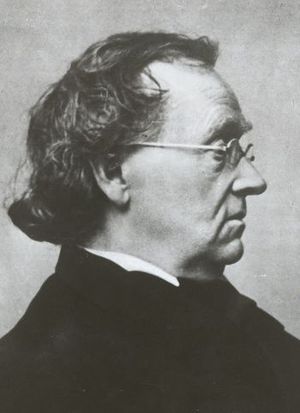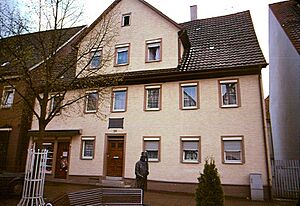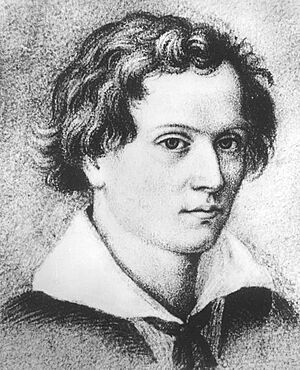Eduard Mörike facts for kids
Quick facts for kids
Eduard Mörike
|
|
|---|---|
 |
|
| Born | 8 September 1804 Ludwigsburg, Electorate of Württemberg |
| Died | 4 June 1875 (aged 70) Stuttgart, Kingdom of Württemberg |
| Occupation | Poet, writer |
| Nationality | German |
| Signature | |
Eduard Friedrich Mörike (born September 8, 1804 – died June 4, 1875) was a German Lutheran pastor. He was also a talented Romantic poet and writer of short stories and novels. Many of his poems were set to music and became well-known folk songs. Other poems were used by composers like Hugo Wolf and Ignaz Lachner in their larger musical works.
Contents
Biography
Eduard Mörike was born in Ludwigsburg, Germany. His father was a medical councilor. When Eduard was 13, his father passed away. After this, he went to live with his uncle in Stuttgart. His uncle wanted him to become a clergyman, which is a religious leader.
So, Eduard attended a special school called the Evangelical Seminary in Urach starting in 1818. From 1822 to 1826, he studied theology at the Seminary of Tübingen. Even though he didn't always get the best grades, he was accepted. At these schools, he studied classic subjects like ancient Greek and Roman literature. This had a big impact on his writing style. He also made many friends who remained important throughout his life. With one friend, Ludwig Bauer, he even invented a magical fairyland called Orplid.
In 1834, Mörike became a Lutheran pastor in a town called Cleversulzbach. He later retired early in 1851 due to health reasons. After retiring as a pastor, he became a professor of German literature in Stuttgart. He taught there until 1866. He continued to live in Stuttgart until he passed away.
In 1843, Mörike spent more than six months visiting his friend Pastor Wilhelm Hartlaub in a village called Wermutshausen. During this time, he drew a picture of the local church. Today, there is a museum in Wermutshausen that remembers his visit. Visitors can even see the room where he lived.
Works
Mörike was part of a group of writers known as the Swabian school. His poems, first published in 1838 as Gedichte, are mostly lyrical. This means they express strong emotions. However, they are also often humorous and written in simple, everyday German. One of his ballads, "Schön Rotraut," became very popular.
His first published work was a novel called Maler Nolten ("The painter Nolten") in 1832. It was a story about a painter's life and showed his amazing imagination. It became quite well-liked. Another famous work is the short story Mozart auf der Reise nach Prag ("Mozart on the way to Prague") from 1856. This story humorously looked at the challenges artists face in a world that doesn't always understand art. Many people consider it his best work.
He also wrote a fantasy story called Idylle vom Bodensee, oder Fischer Martin und die Glockendiebe (1846). Another fairy tale he wrote was Das Stuttgarter Hutzelmännlein (1855). Mörike also translated works from ancient Greek writers like Anacreon and Theocritus into German.
The famous philosopher Ludwig Wittgenstein greatly admired Mörike's work. He said that Mörike was "really a great poet" and that his poems were "among the best things we have."
Musical settings
Many of Mörike's poems were turned into songs by various composers. Hugo Wolf, Ludwig Hetsch, and Ignaz Lachner are some of the composers who set his words to music. Many of his poems became popular folk songs that people still sing today.
As an artist
Besides writing, Mörike also enjoyed drawing. While he was staying in Wermutshausen in 1843, he created a drawing of the Persuskirche. This was a small church built in the early 1800s.
See also
 In Spanish: Eduard Mörike para niños
In Spanish: Eduard Mörike para niños



